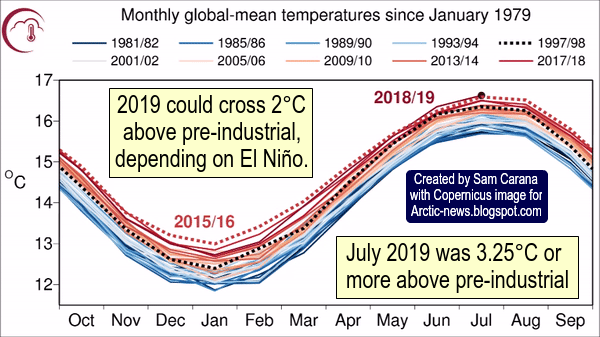Written by Sam Carana / Arctic News
The July 2019 temperature was on a par with, and possibly marginally higher than, that of July 2016, according to a World Meteorological Organization (WMO) news release pointing an image by the Copernicus Climate Change Programme that is used as the background for above image.
Previously, July 2016 was the hottest month on record with a global land and ocean temperature of 16.67°C (62.01°F), or 3.25°C above the pre-industrial temperature of 13.42°C (56.16°F) and surpassing the record set before that, in July 2015.
There’s a spread of more than 3°C between the coldest and hottest monthly temperatures, in line with the seasonal cycle. Since the land/sea ratio is larger on the Northern Hemisphere and land heats up faster than oceans, July typically is the hottest month of the year, so the annual mean temperature for the year 2019 will be somewhat lower than the temperature for July 2019. An earlier analysis points at a potential mean temperature for 2019 of 15.27°C, or 1.85°C above pre-industrial, but depending on the strength of El Niño over the remainder of the year, 2019 could even cross the 2°C guardrail that politicians at the Paris Agreement pledged would not be crossed.
Unbearable heat

As temperatures keep rising, there are places on the northern hemisphere where the July heat is becoming ever harder to bear.The image on the right shows that on July 29, 2019, it felt like it was as hot as 57.2°C or 135°F in China (in the area marked by the green circle).
How could it get this hot? As the image underneath on the right shows, the temperature in that area was 35.1°C or 95.1°F (at the right circle), while it was much hotter at some places elsewhere in China, e.g. it was 41.5°C or 106.6°F at the left circle on July 29, 2019.
What made the weather so hard to bear was a combination of high temperature and high relative humidity, which was 81% in the area at the circle on the right at the time.
The jet stream is becoming ever more deformed as the Arctic heats up faster than the rest of the world. On July 29, 2019, the jet stream was all over the place, with a strong presence north of the circle, which made warm, moist air from the south move over China.
Since the Arctic continues to heat up faster than the rest of the world, such situations are likely to become more common.
Wet Bulb Temperature
The temperature in that area of 35.1°C, at 81% relative humidity and a pressure level of 1004 hPa, translates into a wet bulb temperature of 32.11°C.
Had the temperature remained at 35.1°C, but had relative humidity kept rising to 100%, i.e. rainfall, the wet bulb temperature threshold of 35°C would have been exceeded (35.01°C). Alternatively, had relative humidity remained at 81%, but had the temperature kept rising to 38.2°C, the wet bulb temperature threshold of 35°C would equally have been exceeded (35.07°C), showing how dangerous the situation is. A wet bulb temperature of 35°C can be lethal, as the human body will be unable to lose heat, even when the wind is strong and no matter how much one drinks or sweats.
The situation is dire and calls for comprehensive and effective action, as described in the Climate Plan.


